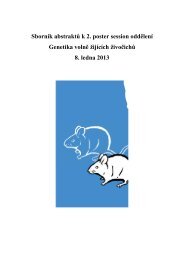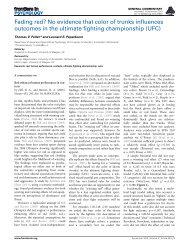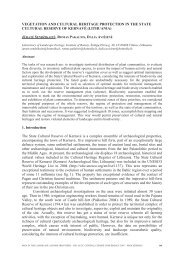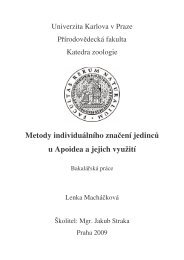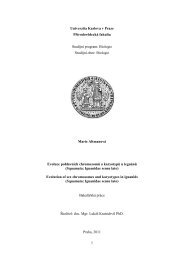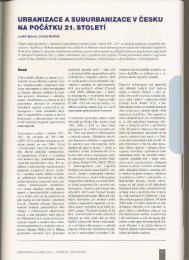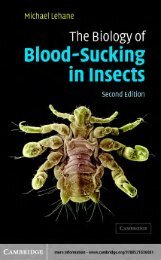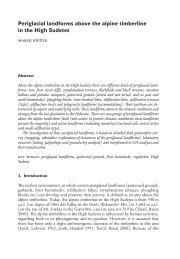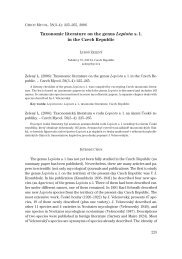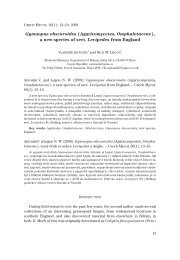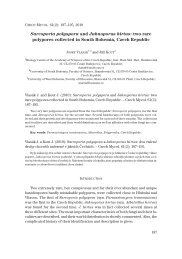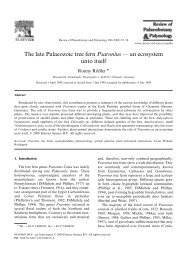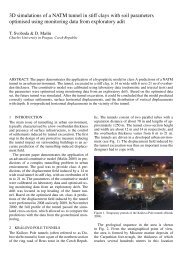Effects of fruit position on fruit mass and seed germination in the ...
Effects of fruit position on fruit mass and seed germination in the ...
Effects of fruit position on fruit mass and seed germination in the ...
You also want an ePaper? Increase the reach of your titles
YUMPU automatically turns print PDFs into web optimized ePapers that Google loves.
(Pyšek <strong>and</strong> Prach, 1993) c<strong>on</strong>tribute to its rapid spread. Disturbed<br />
habitats with good possibilities for <strong>the</strong> <str<strong>on</strong>g>fruit</str<strong>on</strong>g> dispersal<br />
<strong>and</strong> establishment <str<strong>on</strong>g>of</str<strong>on</strong>g> <strong>seed</strong> are readily <strong>in</strong>vaded, but <strong>the</strong> species<br />
also <strong>in</strong>vades sem<strong>in</strong>atural vegetati<strong>on</strong> (Pyšek <strong>and</strong> Pyšek, 1995).<br />
Heracleum mantegazzianum is naturalized or <strong>in</strong>vasive <strong>in</strong><br />
a number <str<strong>on</strong>g>of</str<strong>on</strong>g> European countries <strong>and</strong> Central Russia (see Tiley<br />
et al., 1996 for <strong>the</strong> list <strong>and</strong> references). Outside Europe, it is<br />
found naturalized <strong>in</strong> Canada <strong>and</strong> United States (Mort<strong>on</strong>, 1978;<br />
Ochsmann, 1996; Kartesz <strong>and</strong> Meacham, 1999).<br />
2.2. Germ<strong>in</strong>ati<strong>on</strong> experiments<br />
Data were collected <strong>in</strong> <strong>the</strong> Slavkovský les Protected Area<br />
<strong>in</strong> <strong>the</strong> western part <str<strong>on</strong>g>of</str<strong>on</strong>g> <strong>the</strong> Czech Republic. Seven sites dom<strong>in</strong>ated<br />
by H. mantegazzianum were selected; <strong>the</strong> area covered<br />
by this species at <strong>the</strong> study sites varied from 4 711 to<br />
47 110 m 2 (Table 1). At each site, eight plants were r<strong>and</strong>omly<br />
selected <strong>and</strong> <strong>the</strong>ir <str<strong>on</strong>g>fruit</str<strong>on</strong>g> collected as it ripened <strong>on</strong> several occasi<strong>on</strong>s<br />
dur<strong>in</strong>g August 2002. From each plant, <str<strong>on</strong>g>fruit</str<strong>on</strong>g> was collected<br />
from six morphological <str<strong>on</strong>g>positi<strong>on</strong></str<strong>on</strong>g>s: <strong>the</strong> three umbel <str<strong>on</strong>g>positi<strong>on</strong></str<strong>on</strong>g>s<br />
(term<strong>in</strong>al, satellite <strong>and</strong> branch; termed “umbel type”)<br />
<strong>and</strong> <strong>the</strong> two <str<strong>on</strong>g>positi<strong>on</strong></str<strong>on</strong>g>s with<strong>in</strong> an umbel (centre <strong>and</strong> marg<strong>in</strong>;<br />
termed “<str<strong>on</strong>g>fruit</str<strong>on</strong>g> <str<strong>on</strong>g>positi<strong>on</strong></str<strong>on</strong>g>”) (Fig. 1). Fruit was transported to <strong>the</strong><br />
laboratory <strong>in</strong> labelled paper bags, dried for 2 weeks at room<br />
temperature (20 °C) <strong>and</strong> stored at 15 °C for 8 m<strong>on</strong>ths until<br />
<strong>the</strong> beg<strong>in</strong>n<strong>in</strong>g <str<strong>on</strong>g>of</str<strong>on</strong>g> <strong>the</strong> germ<strong>in</strong>ati<strong>on</strong> experiment. Fruit was kept<br />
for 2 weeks at room temperature (20 °C) before stratificati<strong>on</strong><br />
<strong>and</strong> weigh<strong>in</strong>g.<br />
The experimental design c<strong>on</strong>sisted <str<strong>on</strong>g>of</str<strong>on</strong>g> six treatments (three<br />
umbel types/two <str<strong>on</strong>g>fruit</str<strong>on</strong>g> <str<strong>on</strong>g>positi<strong>on</strong></str<strong>on</strong>g>s) performed <strong>on</strong> eight plants<br />
from seven sites. There were five replicates <str<strong>on</strong>g>of</str<strong>on</strong>g> each<br />
treatment/plant/site comb<strong>in</strong>ati<strong>on</strong>, giv<strong>in</strong>g a total <str<strong>on</strong>g>of</str<strong>on</strong>g> 1680<br />
(=3×2×7×8×5)samples <str<strong>on</strong>g>of</str<strong>on</strong>g> <str<strong>on</strong>g>fruit</str<strong>on</strong>g>. Samples c<strong>on</strong>sist<strong>in</strong>g <str<strong>on</strong>g>of</str<strong>on</strong>g><br />
25 r<strong>and</strong>omly selected healthy <str<strong>on</strong>g>fruit</str<strong>on</strong>g> were weighed <strong>and</strong> placed<br />
<strong>in</strong> Petri dishes with sterilised moist s<strong>and</strong> for stratificati<strong>on</strong>.<br />
Tap water was used <strong>and</strong> <strong>the</strong> <str<strong>on</strong>g>fruit</str<strong>on</strong>g> was not treated with dis<strong>in</strong>fectant.<br />
Fruit was stratified for 2 m<strong>on</strong>ths at 2–4 °C <strong>and</strong> <strong>the</strong>n<br />
germ<strong>in</strong>ated <strong>in</strong> <strong>the</strong> dark at 8–10 °C. This temperature mimics<br />
<strong>the</strong> c<strong>on</strong>diti<strong>on</strong>s <strong>the</strong> <str<strong>on</strong>g>fruit</str<strong>on</strong>g> is exposed to dur<strong>in</strong>g germ<strong>in</strong>ati<strong>on</strong> <strong>in</strong><br />
spr<strong>in</strong>g. In <strong>the</strong> study area, March <strong>and</strong> April temperatures are<br />
L. Moravcová et al. / Acta Oecologica 28 (2005) 1–10<br />
Fig. 1. Diagram <str<strong>on</strong>g>of</str<strong>on</strong>g> <strong>the</strong> umbel types <strong>and</strong> <str<strong>on</strong>g>positi<strong>on</strong></str<strong>on</strong>g>s <str<strong>on</strong>g>of</str<strong>on</strong>g> <strong>the</strong> <str<strong>on</strong>g>fruit</str<strong>on</strong>g> <strong>on</strong> a plant <str<strong>on</strong>g>of</str<strong>on</strong>g><br />
H. mantegazzianum. This is relevant to <strong>the</strong> term<strong>in</strong>ology used <strong>in</strong> <strong>the</strong> germ<strong>in</strong>ati<strong>on</strong><br />
experiments. Umbel <str<strong>on</strong>g>positi<strong>on</strong></str<strong>on</strong>g>: T – term<strong>in</strong>al, S – satellite, B – branch;<br />
<str<strong>on</strong>g>fruit</str<strong>on</strong>g> <str<strong>on</strong>g>positi<strong>on</strong></str<strong>on</strong>g>: c – centre, m – marg<strong>in</strong>.<br />
ra<strong>the</strong>r low <strong>and</strong> rarely exceed 10 °C. Pilot experiments us<strong>in</strong>g<br />
<str<strong>on</strong>g>fruit</str<strong>on</strong>g> from <strong>the</strong> study area showed that germ<strong>in</strong>ati<strong>on</strong> is not<br />
affected by light <strong>and</strong> that <strong>seed</strong>s germ<strong>in</strong>ate at up to 10 cm below<br />
<strong>the</strong> soil surface (L. Moravcová et al., unpublished data).<br />
Germ<strong>in</strong>ati<strong>on</strong> was recorded weekly start<strong>in</strong>g <strong>on</strong> 24 July 2003.<br />
S<strong>in</strong>ce <strong>the</strong> aim was to determ<strong>in</strong>e <strong>the</strong> germ<strong>in</strong>ati<strong>on</strong> potential <str<strong>on</strong>g>of</str<strong>on</strong>g><br />
this species (as a crucial feature <str<strong>on</strong>g>of</str<strong>on</strong>g> its <strong>in</strong>vasi<strong>on</strong> potential), <strong>the</strong><br />
experiment was run for 6 m<strong>on</strong>ths. Fruit that decayed dur<strong>in</strong>g<br />
<strong>the</strong> experiment was c<strong>on</strong>sidered dead, viable <strong>seed</strong>s that did<br />
not germ<strong>in</strong>ate were c<strong>on</strong>sidered to be dormant. The viability<br />
<str<strong>on</strong>g>of</str<strong>on</strong>g> dormant <strong>seed</strong>s was tested by squeez<strong>in</strong>g <strong>the</strong> <str<strong>on</strong>g>fruit</str<strong>on</strong>g> us<strong>in</strong>g forceps.<br />
Prior to <strong>the</strong> experiment, <strong>the</strong> results obta<strong>in</strong>ed us<strong>in</strong>g <strong>the</strong><br />
tetrazolium test were compared with those obta<strong>in</strong>ed by<br />
squeez<strong>in</strong>g <strong>the</strong> <str<strong>on</strong>g>fruit</str<strong>on</strong>g>; <strong>the</strong> proporti<strong>on</strong> <str<strong>on</strong>g>of</str<strong>on</strong>g> dead <str<strong>on</strong>g>fruit</str<strong>on</strong>g> was very low<br />
(4.8%) <strong>and</strong> not c<strong>on</strong>sidered <strong>in</strong> <strong>the</strong> statistical analyses.<br />
Table 1<br />
Geographical locati<strong>on</strong>, altitude (m a.s.l.) <strong>and</strong> populati<strong>on</strong> size <str<strong>on</strong>g>of</str<strong>on</strong>g> Heracleum mantegazzianum estimated from aerial photographs taken <strong>in</strong> 1996, except as<br />
<strong>in</strong>dicated (J. Müllerová et al., Institute <str<strong>on</strong>g>of</str<strong>on</strong>g> Botany Pru˚h<strong>on</strong>ice, unpublished). Percentage germ<strong>in</strong>ati<strong>on</strong> (mean ± <strong>the</strong> central 50% <str<strong>on</strong>g>of</str<strong>on</strong>g> <strong>the</strong> data) is shown for particular<br />
treatments, i.e. umbel types (term<strong>in</strong>al, satellites, branches; pooled across <str<strong>on</strong>g>fruit</str<strong>on</strong>g> <str<strong>on</strong>g>positi<strong>on</strong></str<strong>on</strong>g>s) <strong>and</strong> <str<strong>on</strong>g>fruit</str<strong>on</strong>g> <str<strong>on</strong>g>positi<strong>on</strong></str<strong>on</strong>g>s (central, marg<strong>in</strong>al; pooled across umbel types).<br />
Values are based <strong>on</strong> 8 plants <strong>and</strong> 5 replicates, giv<strong>in</strong>g <strong>the</strong> sample sizes n = 80 <strong>and</strong> 120 for umbel type <strong>and</strong> <str<strong>on</strong>g>fruit</str<strong>on</strong>g> <str<strong>on</strong>g>positi<strong>on</strong></str<strong>on</strong>g>, respectively. For localities pooled across<br />
treatments n = 240 <strong>and</strong> for <strong>the</strong> gr<strong>and</strong> total n = 1680.<br />
Site characteristics F<strong>in</strong>al germ<strong>in</strong>ati<strong>on</strong><br />
Locality Latitude L<strong>on</strong>gitude Altitude<br />
(m a.s.l.) Populati<strong>on</strong><br />
(m2 )<br />
Term<strong>in</strong>al Satellite Branches Central Marg<strong>in</strong>al Total<br />
Arnoltov 50°06.801 12°36.147 575 47 170a 90.9(86–96) 91.1(88–9 6) 90.5(80–96) 90.9(84–96) 91.0(84–96) 90.9(84–96 )<br />
Dvorečky 50°05.982 12°34.137 506 24 817 90.0(80–92) 90.6(84 –96) 91.3(84 –100) 91.1(84–96) 91.1(80–96) 91.1(80–96)<br />
Krásná Lípa 1 50°05.692 12°38.544 597 n. a. 91.4(89–100) 90.6(87–100) 91.1(87 –96) 91.2(88–9 6) 91.2(88–100) 91.1(87–9 8)<br />
Krásná Lípa 2 50°06.306 12°38.393 596 7945a 91.(88–100) 90.9 (88–100) 91 .0(88–96) 91.2(88–100) 91.1 (88–96) 91.0(88–100)<br />
Litrbachy 50°06.009 12°43.777 800 4711 90.2(8 0–94) 90.6(80–96) 90.8 (90–100) 90.9(84–96) 90.7(84–9 6) 90.9(84–96)<br />
Žitný I 50°03.754 12°37.569 787 99 121 91.4(90–100) 91.0(88–100) 91.6(88–100) 91.3 (88–100) 91.2(90 –100) 91.2(90–100)<br />
Žitný II 50°03.837 12°37.304 734 65 273 91.2 (88–100) 91.7(90–100) 91.4(89–100) 91.2(90–100) 91.3(90–100) 91.2(90–100)<br />
Total<br />
a<br />
from 2000.<br />
90.9(8 8–97) 91.2 (86–98) 91.2(86–98) 91.2(8 7–98) 91.1(86 –98) 91.1(88 –100)<br />
3



